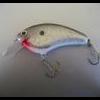Jon, looks like you did a very good job of keeping it symmetrical. Harder to do than to say, oui? Nice work! I tried PVC and Alumite but I'll always be a "wood guy". Most of the man made materials are consistent but also heavier than stuff I like to use, like balsa and basswood. You develop a knowledge base on how to work a particular material, how to finish it, and especially how to design baits incorporating it. When you switch materials, there's a lot you have to re-learn - in other words, you must take several steps backwards. Most guys build better baits faster if they stick with one or two materials until they master them. If Sintra's your bag - Salut!



